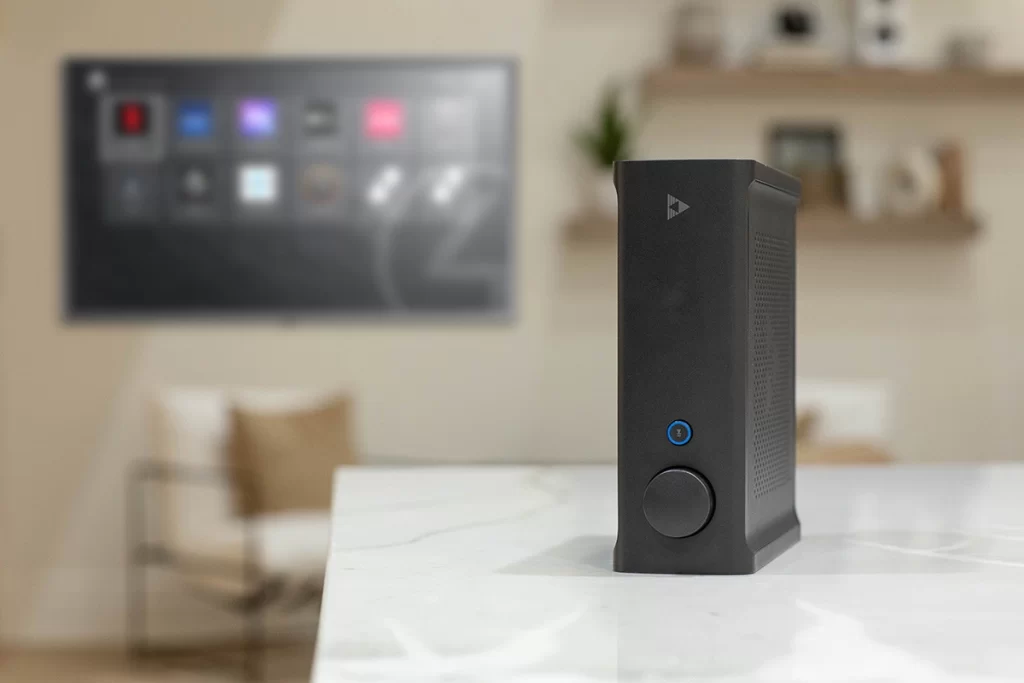When it comes to enjoying a truly immersive audio experience at home, knowing your audio source options is key. This past weekend, Andrew and I hosted a few friends at our winehouse in the Balaton Highlands for the local “Trout and Wine Festival“. The whole place felt alive, and we made the most of the multiple zones in our audio system to set the perfect mood.
Friday evening kicked off on the upper terrace, where we sipped wine and listened to music while the sun dipped below the horizon. Later, we moved to the lower terrace to project a film onto the side of our cottage—soundtrack and all, courtesy of the Control4 Core 5 controller. With the audio flowing seamlessly between the two spaces, we moved effortlessly from music to cinema, all while staying connected through the same central setup.
As we spent the weekend nestled amongst the vines, I couldn’t help but reflect on how versatile our home audio system had to be. Whether we were streaming music, tuning into a podcast, or watching a movie, having the right audio source options made every moment sound just right.

One of our Triad OD-26 outdoor speakers peeking out under the eaves, delivering the perfect soundtrack for sunsets and soirées on the terrace. Two pairs, total coverage—let the music play.
Why Versatility in Audio Sources Matters
Having the freedom to choose your audio sources isn’t just a matter of preference—it’s about creating a personalised atmosphere that can change with your mood, your guests, or the occasion. Today’s distributed audio systems, like ours, make it easy to mix and match sources, so you’re never locked into just one format. Whether you’re streaming the latest playlist, digging out an old vinyl record, or connecting a device with a simple USB, there’s a solution for every scenario.
For us, this versatility is essential. Our winehouse may be a retreat, but it’s also a space where we entertain regularly, and the sound has to be as adaptable as our plans. Moving from soft background music at sunset to full surround sound for a film is all part of what makes the experience special—and that’s all thanks to a system that works with multiple sources.
Audio Source Options Overview
Whether you’re setting up an audio system for a new home or upgrading your existing setup, it’s essential to know the different audio source options available. Here’s a breakdown of six key options, each offering its own advantages depending on your needs.
1. eARC (Enhanced Audio Return Channel)
eARC is an upgrade from the older ARC (Audio Return Channel), offering a higher-quality audio connection between your TV and home audio system. It’s designed to handle high-resolution audio formats like Dolby Atmos, making it ideal for movie nights or streaming services that support immersive sound.
Best for: Home cinemas or spaces where you want top-quality sound for both music and video.
Benefits: Superior sound clarity, no lip-sync issues, supports advanced audio formats.
2. Bluetooth
Bluetooth is the go-to option for quick, wireless connections. It’s perfect for when guests want to share their music, or if you want to stream audio from your phone without needing to mess with cables.
Best for: Casual streaming from mobile devices during social gatherings.
Benefits: Easy to use, widely compatible, wire-free flexibility.
3. XLR
XLR connectors are a professional-grade option typically found in high-end audio equipment. They offer balanced audio and reduced noise, making them a favourite for audiophiles and anyone seeking pristine sound quality. We have an XLR connection on the terrace, which really comes in handy for those late-night karaoke sessions.
Best for: Audiophiles or setups where sound quality and noise reduction are paramount.
Benefits: Balanced audio, less noise, high fidelity.
4. Analog Audio Devices
For those who still have a soft spot for analog devices like record players or old cassette decks, they can still be easily integrated into a modern audio system. In our case, Andrew loves playing vinyl during lazy afternoons, and our system handles it beautifully. It’s all about blending the old with the new.
Best for: Fans of vintage sound equipment who don’t want to part with their old favourites.
Benefits: Warm sound profile, nostalgic appeal, compatibility with legacy devices.
5. USB & AUX Input
USB and AUX inputs are simple but reliable methods to connect various devices to your audio system. These are the everyday workhorses of any system, offering universal compatibility with a wide range of devices. From laptops to older MP3 players, this option ensures that whatever device you have on hand, you can plug in and play. We find it particularly useful when someone just wants to connect their phone for a quick playlist swap.
Best for: Quick and easy connections with mobile devices, laptops, or legacy audio gear.
Benefits: Universal compatibility, plug-and-play ease, no setup needed.
6. Streaming Amplifiers
Finally, for those of us who stream music as our primary source, streaming amplifiers with built-in services are a must-have. Our Control4 Core 5 system has this built in, making it incredibly easy to access Apple Music or Tidal without needing extra devices or cables. When you’re hosting, the last thing you want is to fiddle with settings—this just works.
For entertainment, CORE 5 includes new, higher quality DACs (digital to analog converters) with audiophile-grade signal-to-noise ratio of 118dB, and powerful new DSPs that provide ultra-fine controls for a fully customisable 6-band equaliser with graphical display. Each of the audio outputs – three digital audio outputs, three analog audio outputs, and an HDMI output – can be independently streamed simultaneously by Ryff.
The Ryff audio platform provides up to a 24-bit/192kHz decoding, and includes MQA support. It also includes network-based audio synchronisation to prevent echoes and lag across multiple simultaneous zones, including those connected wirelessly. In addition, the Ryff audio experience integrates 12 of the most popular streaming services, including Pandora, Spotify, SiriusXM, TIDAL, Apple Music, and more.
Best for: Households that rely on streaming services for everyday music.
Benefits: High-quality streaming, no extra devices needed, access to a huge library of content.

Triad SA1 Streaming Amplifier offers a range of premium features including 2x200w power, HDMI ARC/eARC capability, advanced integration support for Control4 and MoIP systems, presets for Triad and Episode speakers, a 6-band parametric EQ and improved connector options and hardware.
Conclusion
With these six audio source options, you can make your home sound system as flexible and functional as you need it to be. From impromptu playlists to high-fidelity sound, there’s a solution for every kind of listener and every occasion. For us, it’s all about enhancing the experience—whether that’s sipping wine as the sun sets, hosting a karaoke night, or ending the evening with a movie under the stars.
As we head into October, a very busy month for us, we’ve officially said goodbye to summer. But with a system like this, we’re ready to welcome any season with perfect sound.
Ready to elevate your own home audio experience? Get in touch with us at S3 Europe to find the perfect solution for your space and start connecting it all.



0 Comments